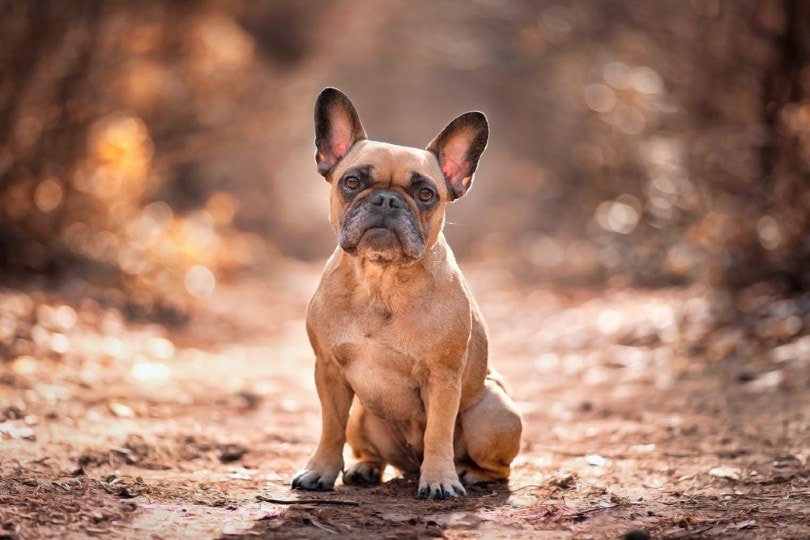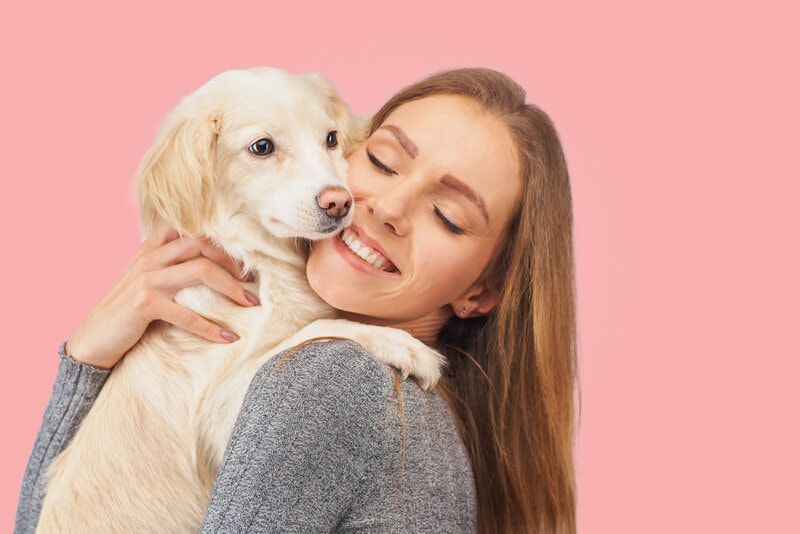Dog Breeds With Green Eyes: Pictures, Info & Rarity Explained

Updated on
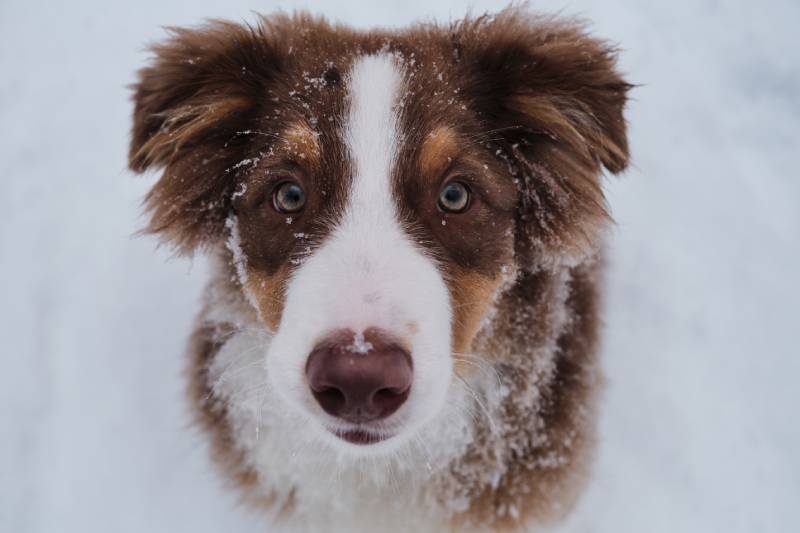
Sometimes, all it takes to fall in love with a dog is a quick look into those big, beautiful eyes. They radiate kindness, loyalty, and affection. And you can just tell by gazing into a pup’s eyes that it will follow you to the edge of the world. Now, most canines have brown eyes; hazel and blue are fairly common as well. Green, however, is the rarest color.
It gives our four-legged friends exotic and mysterious vibes. So, what makes a pup’s eyes turn green? Which breeds are born with this color? Does it change during adulthood? More importantly, what common health issues do canines with verdant eyes tend to have? Our dog experts have the answers!
How Are Green-Eyed Dogs Classified?
Just like humans, dogs have their genes to thank for the wide range of available colors. And most pups are born with brown or hazel eyes because of a dominant gene called MC1R. It controls the black/dark brown pigment (eumelanin) and instructs it to color the iris of the eyes. This gene also chooses the color of the dog’s coat, facial features, and paws.
For the eyes to be green, MC1R needs the help of another gene, like the Merle (M) gene. Together, they gift the pup with amber, blue, or verdant eyes. And if your dog has green eyes and a patchy or brindle coat, that means there’s little to no eumelanin in the pet’s body. This mostly applies to hybrids, though: for purebreds, green eyes are almost never a standard.
The 15 Dog Breeds With Green Eyes
1. Alaskan Malamute
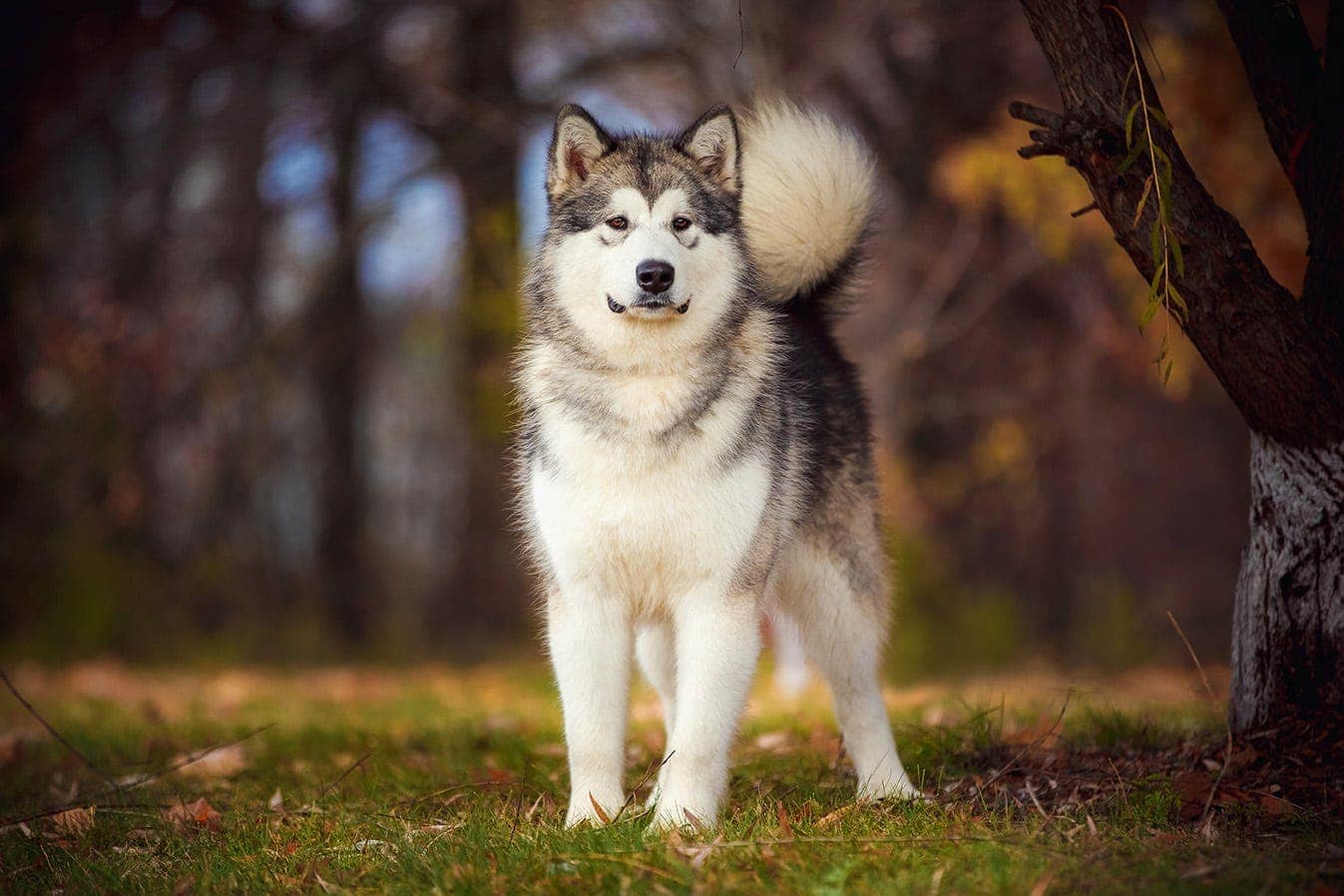
| Origin: | Alaska |
| Lifespan: | 10–14 years |
| Height: | 23–26 inches |
| Weight: | 70–85 pounds |
Native to the harsh yet beautiful Alaskan region, these dogs are rough, tough, and ready to take on hard work. Purebred Malamutes are often born with blue eyes, yet they change into brown once they mature. But if it’s a hybrid, you can expect the eyes to stay blue or even green for the rest of its life. Playful, faithful, and full of life, these pups are instantly recognized by their plumed tail and erect ears.
The heavy bone structure, impressive height (up to 25 inches), and dense coat, in turn, turn them into near-perfect working dogs.
2. American Pit Bull Terrier
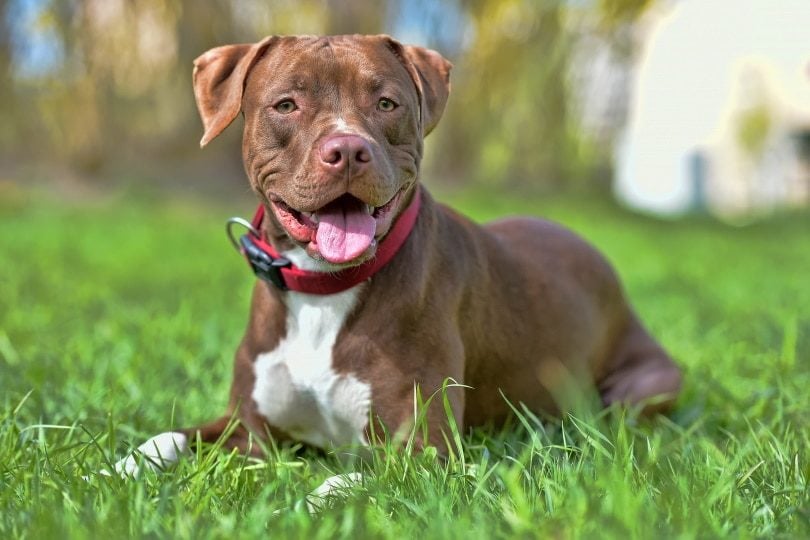
| Origin: | United States |
| Lifespan: | 8–15 years |
| Height: | 17–21 inches |
| Weight: | 30–60 pounds |
Born and bred to help around the property, American Pit Bull Terriers excel at herding livestock, hunting prey, and guarding the farm. But these days, they’re mostly “employed” as companions, despite the somewhat troubling and violent past. Also, in contrast to most canine breeds, these dogs get those emerald eyes naturally (not as a result of crossbreeding).
So, if you’ve been looking for a loyal, intelligent, and protective purebred with mesmerizing green eyes, you just found it!
3. Australian Shepherd
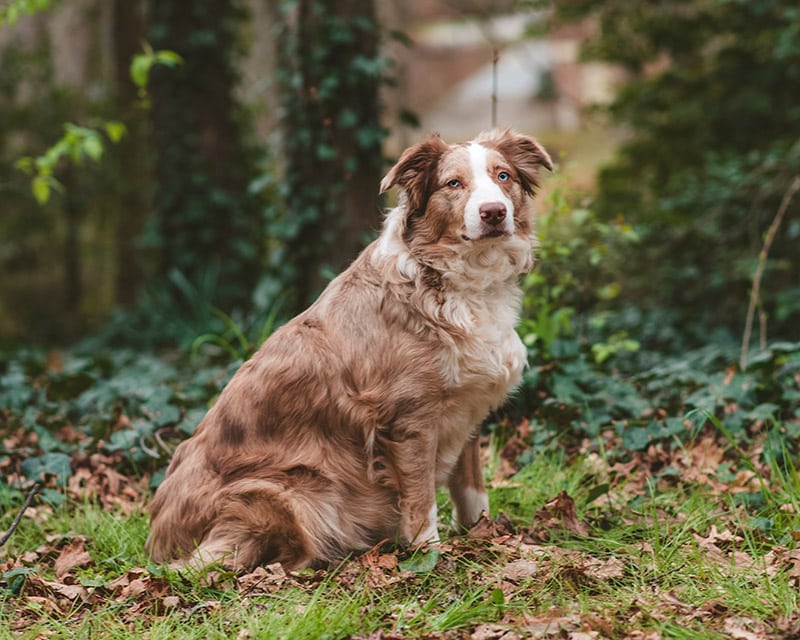
| Origin: | Western United States |
| Lifespan: | 13–15 years |
| Height: | 18–23 inches |
| Weight: | 35–70 pounds |
Don’t let common sense fool you: these Shepherd dogs are NOT from Australia! Instead, they were brought up in the States. And, when it comes to their eyes, Australian Shepherds are very diverse. The colors include brown, hazel, amber, blue, and, of course, green. Also, it’s not rare for them to have heterochromia (that’s when each eye has its own color).
Now, green eyes are quite a rare sight in the Canine Kingdom, but if you adopt an Australian Shepherd, the probability will be relatively high.
4. Border Collie
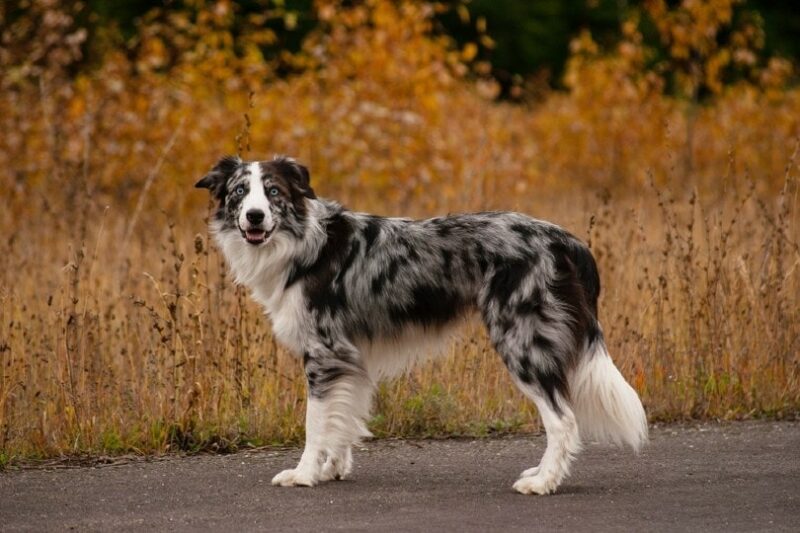
| Origin: | UK, Scotland, Ireland, Wales |
| Lifespan: | 10–17 years |
| Height: | 18–22 inches |
| Weight: | 27–45 pounds |
Despite the average size, Border Collies are incredibly strong, enduring, and energetic. They like to work hard and play hard (get cute and cuddly with their owners). The list of available coat colors and markings is quite impressive as well. As for the eyes, depending on the dominant gene in the pup’s body, they can be brown, hazel, blue, or green.
Also, just like Australian Shepherds, these dogs are genetically predisposed to heterochromia.
5. Boston Terrier
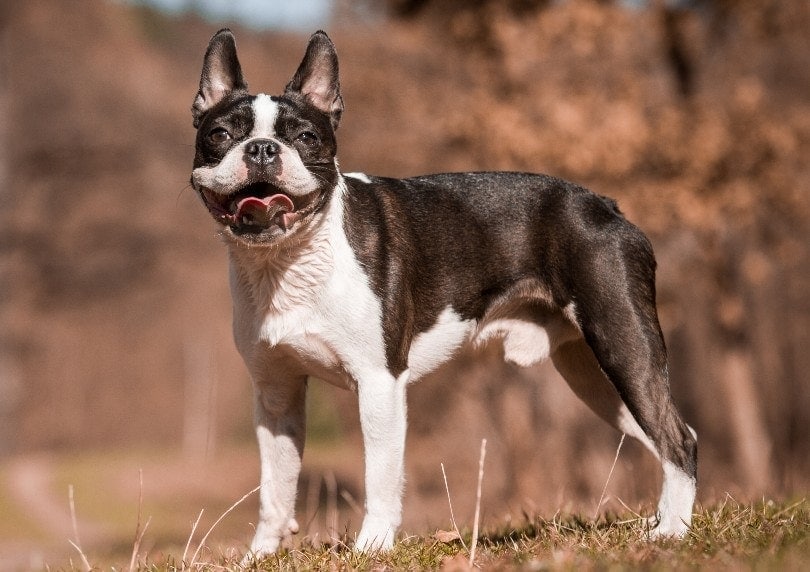
| Origin: | United States |
| Lifespan: | 11–14 years |
| Height: | 10–12 inches |
| Weight: | 12–25 pounds |
Green is a very rare color for the Boston Terrier‘s eyes, but it’s still possible. If you adopt a green-eyed pooch from a local shelter, do keep in mind that it won’t be allowed in most competitions/shows. This color is not accepted by the AKC and many other kennel clubs. On the bright side, Boston’s lovely personality, tuxedo jacket, and a pair of glowing emerald eyes will be well worth it.
After all, the “American Gentleman” is one of the most amusing, fun, and rewarding pets to have around!
6. Chihuahua

| Origin: | Mexico |
| Lifespan: | 14–18 years |
| Height: | 3–8 inches |
| Weight: | 3–6 pounds |
When a Chihuahua pup gets the sable merle gene from one of its parents, it often ends up with green-colored eyes. There are no guarantees here, of course, but if it’s a long-haired doggo, the chances will be a bit higher. Unfortunately, this also means the pet might be born with certain medical conditions. For this reason, Chihuahua dogs with green eyes are not recognized by kennel clubs.
So, make sure to have the four-legged champ checked by an animal doctor regularly to stay on top of any potential health issues.
7. Dachshund
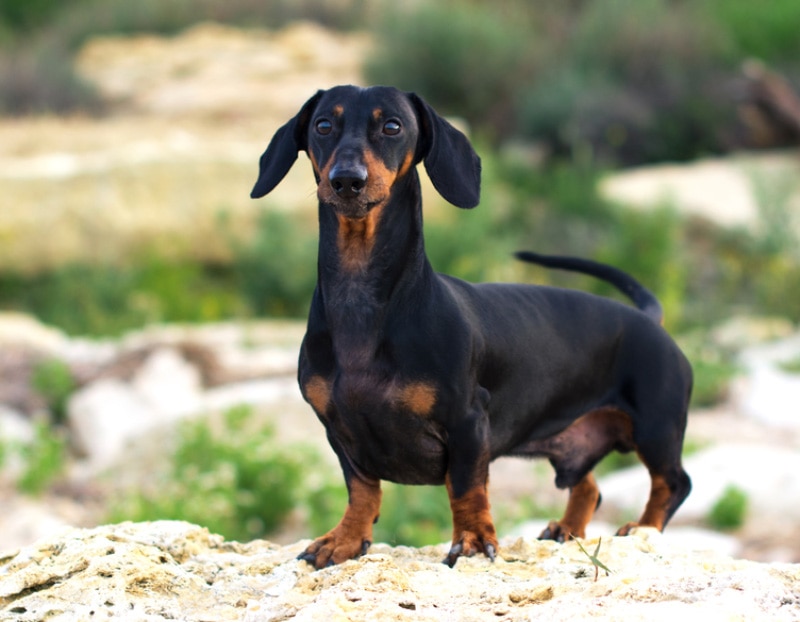
| Origin: | Germany |
| Lifespan: | 2–16 years |
| Height: | 7–9 inches |
| Weight: | 16–32 pounds |
These curious, friendly, and buoyant dogs look mesmerizing with verdant eyes. It’s a perfect match for their cute faces, adorable ears, and cheerful temperament. If you want to get yourself a pup like that, look for a light-colored Dachshund, as they mostly have amber, light brown, or green eyes. This applies to both standard-size and miniature pets, by the way.
8. English Springer Spaniel
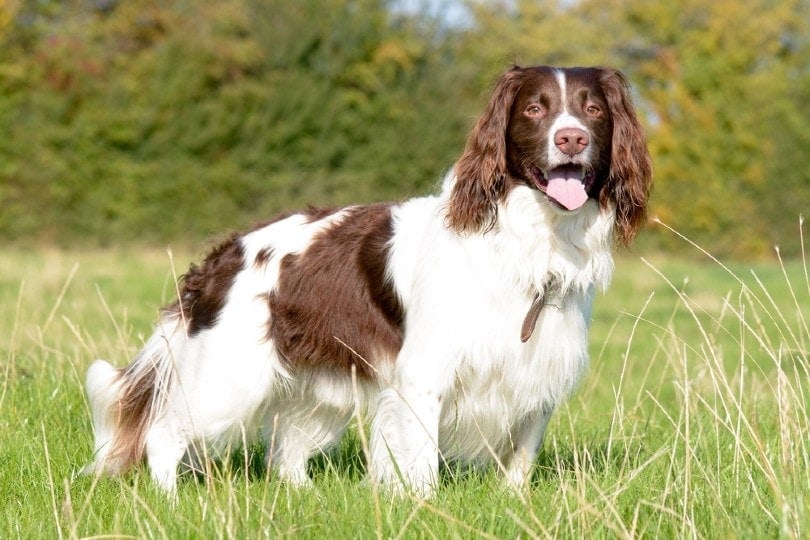
| Origin: | England |
| Lifespan: | 12–14 years |
| Height: | 19–20 inches |
| Weight: | 40–50 pounds |
Bred many centuries ago to hunt birds, English Springer Spaniels are among the smartest and most capable dog breeds. They have stamina for days and can easily track down the most elusive prey. On top of that, Springers are amazing pets that create strong bonds and happily follow commands. And it’s not rare for them to have beautiful green eyes.
That said, most pups switch to dark brown, black, or hazel once they enter adulthood.
9. Great Dane
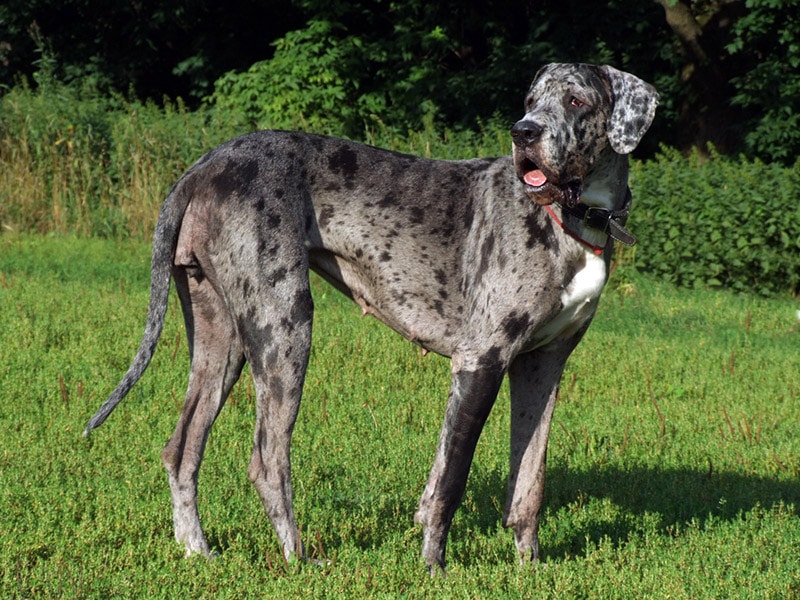
| Origin: | Germany |
| Lifespan: | 7–10 years |
| Height: | 28–32 inches |
| Weight: | 100–180 pounds |
Brown, blue, amber, hazel, and green—the list of available Great Dane eye colors is quite large. But this primarily applies to Merle and Harlequin Danes (they rock a lush white coat covered in black dots). So, if you haven’t been having any luck with fawn, blue, or brindle fur, try your luck with one of these coats. With that, please consider the formidable size of these German dogs.
Adult males often reach 180 pounds in weight and 32 inches in height!
10. Labrador Retriever
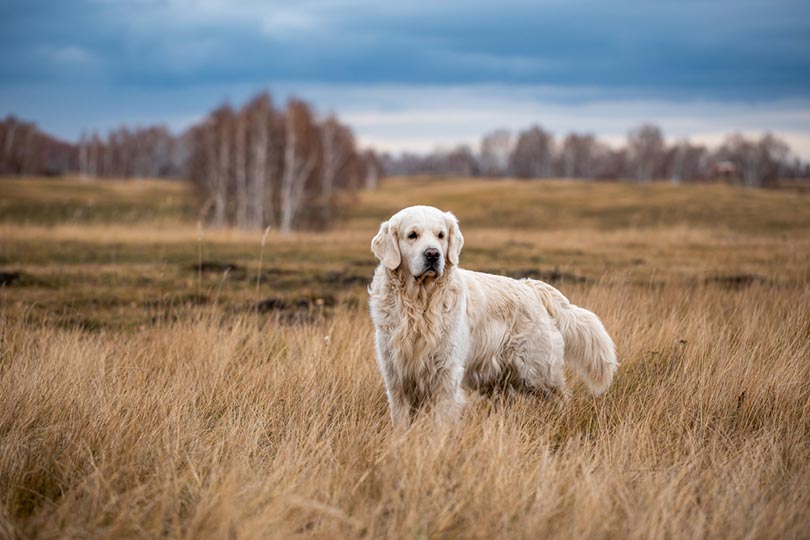
| Origin: | UK, Newfoundland |
| Lifespan: | 11–13 years |
| Height: | 5–24.5 inches |
| Weight: | 55–80 pounds |
Today, you’ll be hard-pressed to find a dog breed that’s more popular than the Lab. This is an affectionate, friendly, and playful pet that’s open to strangers, quick to adapt, and always happy to goof around with its human family. Now, blue or green eyes are not accepted as standard by the AKC, nor are they common.
We recommend opting for a Labrador with a chocolate coat, as it might just have hazel/greenish eyes.
11. Catahoula Leopard Dog
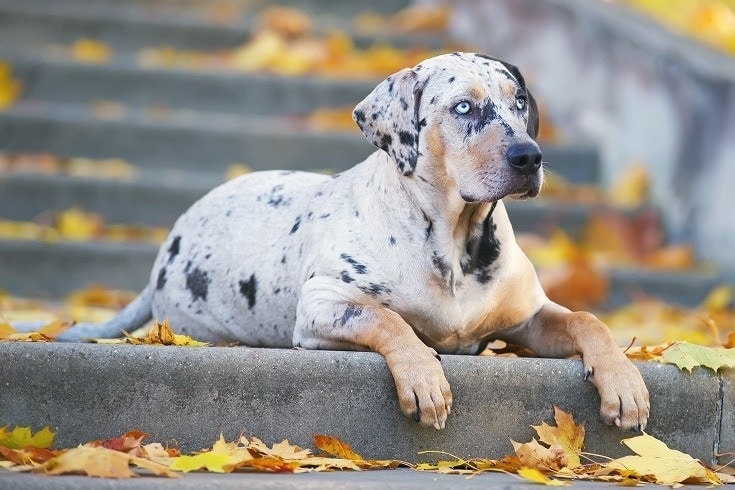
| Origin: | United States (Louisiana) |
| Lifespan: | 10–14 years |
| Height: | 20–24 inches |
| Weight: | 40–95 pounds |
Looking for an alert, watchful, and witty guardian to join your ranks? Then you won’t regret adopting a Catahoula Leopard Dog. Brown, pale blue, and amber are the most prevalent eye colors for these Louisiana dogs, but green is also common, just like different-color eyes. As for the coat, yellow, white, red, and blue merle are all available and recognized by AKC as standard.
No matter which one you choose, you’ll get a strong, muscular, multi-purpose working pup and companion.
12. Miniature Schnauzer
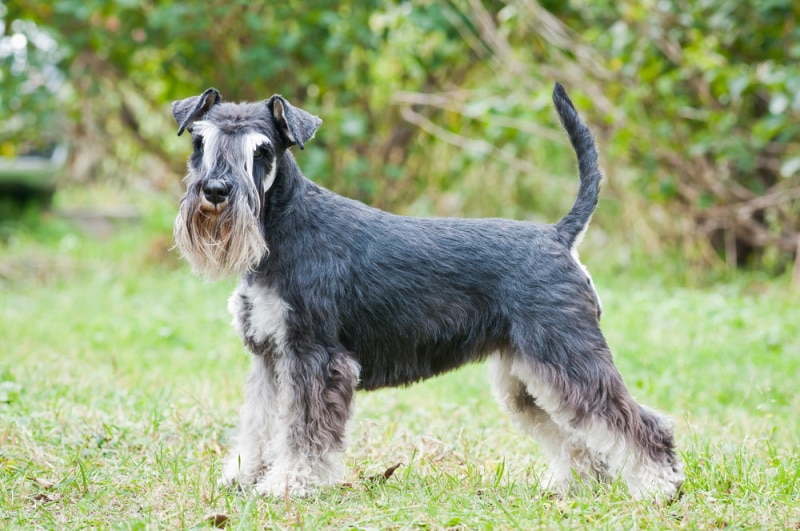
| Origin: | Germany |
| Lifespan: | 12–15 years |
| Height: | 12–14 inches |
| Weight: | 11–20 pounds |
The first things that grab the attention when looking at this German bud are the beard and the brows. However, Miniature Schnauzers are more than just lovable companions. They are healthy, athletic, and oh-so-charming, with a strong work ethic and a love for the outdoors. So, what about those green eyes? Look for a Mini with a brown coat and white markings.
These dogs tend to have hazel or verdant eyes that highlight their friendly, tranquil nature.
13. Pomeranian
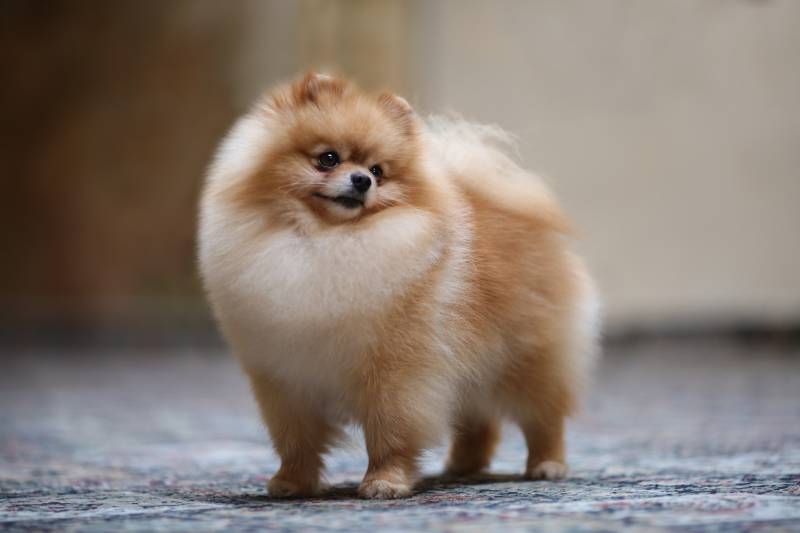
| Origin: | Germany, Poland |
| Lifespan: | 12–16 years |
| Height: | 6–7 inches |
| Weight: | 3–7 pounds |
Here, we have another adorable pet with a curious, cheerful, and energetic temperament. Pomeranians aren’t miniature dogs; instead, they’re a toy breed. With a max weight of seven pounds and an average height of 6–7 inches, these canines are the epitome of cute and cuddly. And, when the stars align (or, rather, the right genes get mixed), they can have green eyes.
Dark brown is the most common eye color, but blue, lavender, and verdant are not unheard of.
14. Siberian Husky

| Origin: | Siberia, Russia |
| Lifespan: | 12–15 years |
| Height: | 20–24 inches |
| Weight: | 35–60 pounds |
These hard-working sled dogs were bred to pull loads, work in packs, and withstand the unforgiving northern climate. Siberian Huskies are loyal, affectionate, and playful dogs known for their almond-shaped eyes. As for the colors, most pups are born with blue or brown eyes (or a combination of both). Green can be a part of the deal as well, but it’s not accepted by the AKC.
Oh, and by the way, Pomsky (a Pomeranian and Siberian hybrid) can also have green eyes.
15. Weimaraner
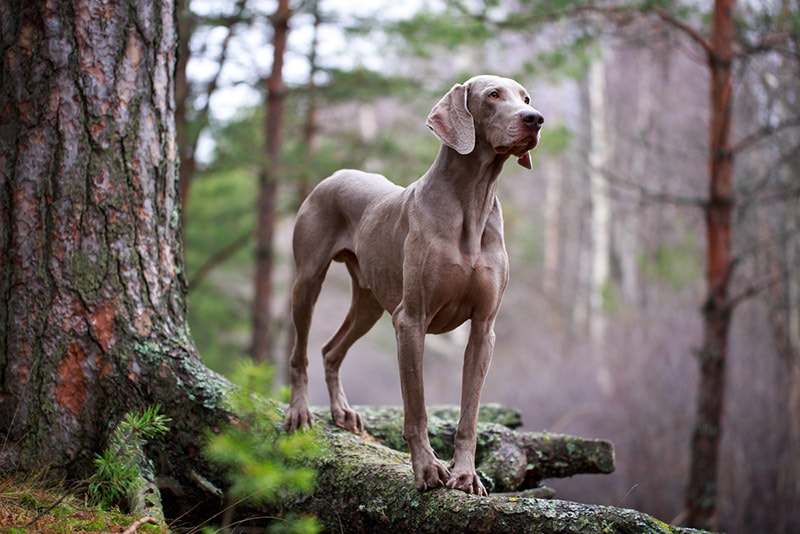
| Origin: | Germany |
| Lifespan: | 11–14 years |
| Height: | 23–27 inches |
| Weight: | 55–85 pounds |
Finishing up, we have one of the tallest dog breeds joining the list. At birth, Weimaraners tend to have blue eyes, but the color changes into gray, blue-gray, and amber as they grow. So, how does green fit in this picture? Well, amber is often called golden green, and depending on the genetic code of the pup, the eyes might go full-green as it matures.
If that’s exactly how it goes, you’ll become the lucky owner of a big, strong, and fearless Gray Ghost with a unique feature.
Are Green-Eyed Dogs Prone to Health Issues?
Dogs with the Merle gene are, indeed, prone to specific medical conditions that affect the eyes. For example, pups with green eyes often have underdeveloped irises. But it’s not that big of an issue as it doesn’t affect the dog’s vision much. In contrast, glaucoma is a very serious condition; when left untreated, it can make the dog go blind.
Glaucoma mostly affects Cocker Spaniels, Great Danes, and Siberian Huskies. The Merle gene can also be responsible for bad hearing. If the doggo is lucky, the impact will be minimal. Unfortunately, when the “green gene” is too strong, that may negatively affect ear development, leading to complete blindness over time. Responsible breeders will notice this, of course, but a pet store might not.
My Puppy’s Eyes Color Has Changed: Is That Normal?
Yes, this is a natural process for dogs. Quite often, they are born with green, blue, or amber eyes but switch to another color as they age. On average, it takes most puppies 2–3 months to “decide” on the color. But sometimes, it can go on for four months straight. High doses of eumelanin paint the eyes brown, while green and blue are clear signs of low or non-existent black pigmentation.
So, does this mean the eyes don’t change in color at a later stage in a dog’s life? No, it does happen, but that’s usually a side effect of a disease like cataracts, uveitis, or nuclear sclerosis. So, if you’re noticing strange things about your dog’s eyes, have it checked by a vet. Hopefully, the lens is changing due to aging, and there’s nothing to worry about.
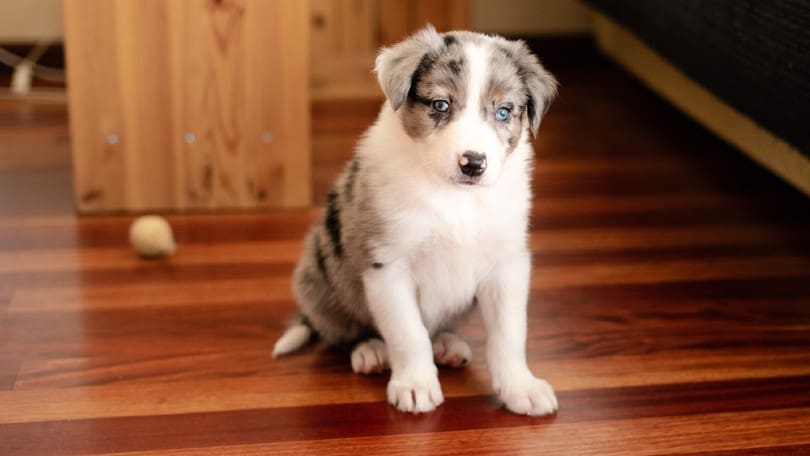
Conclusion
Green-eyed dogs are equally rare and beautiful. If you adopt a pup like that, it will definitely turn heads. That said, dogs that carry the Merle gene are vulnerable to a wide range of health issues, and it’s our responsibility as pet parents to take that into account. Today, we checked out 15 dog breeds with verdant eyes.
For some of them, this is a common color; others are mostly born with brown or blue eyes but can also go with green. It all comes down to genetics and also which parent the pup takes after. Still, if you’re a big fan of emerald eyes, there are quite a few breeds to pick from!
Featured Image Credit: lightman_pic, Shutterstock



